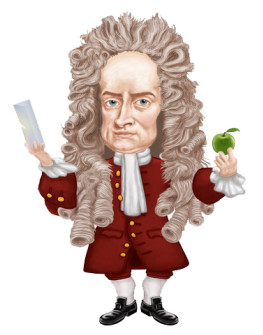FORCES IN MOTION
|
Sir Isaac Newton was one of the greatest scientists and mathematicians that ever lived. He was born in England on December 25, 1643. He was born the same year that Galileo died. He lived for 85 years. Isaac Newton was raised by his grandmother. He attended Free Grammar School and then went on to Trinity College Cambridge. Newton worked his way through college. While at college he became interested in math, physics, and astronomy. Newton received both a bachelors and masters degree.
While Newton was in college he was writing his ideas in a journal. Newton had new ideas about motion, which he called his three laws of motion. He also had ideas about gravity, the diffraction of light, and forces. Newton's ideas were so good that Queen Anne knighted him in 1705. His accomplishments laid the foundations for modern science and revolutionized the world. Sir Isaac Newton died in 1727. Click on Newton's laws to learn more! |
Newton's 1st Law of Motion
An object at rest will remain at rest unless acted on by an unbalanced force. An object in motion continues in motion with the same speed and in the same direction unless acted upon by an unbalanced force.
This means that there is a natural tendency of objects to keep on doing what they're doing. All objects resist changes in their state of motion. In the absence of an unbalanced force, an object in motion will maintain this state of motion.
Newton's 2nd Law of Motion
Acceleration is produced when a force acts on a mass. The greater the mass (of the object being accelerated) the greater the amount of force needed (to accelerate the object).
Everyone unconsciously knows the Second Law. Everyone knows that heavier objects require more force to move the same distance as lighter objects.
Newton's 3rd Law of MotionFor every action there is an equal and opposite re-action.
This means that for every force there is a reaction force that is equal in size,
but opposite in direction. That is to say that whenever an object pushes another object it
gets pushed back in the opposite direction equally hard.
|
Force in Motion:
Running Start videos:
basketball https://www.youtube.com/watch?v=XWrMFPoKYTY
gymnastics http://www.youtube.com/watch?v=Y6X7qFDiscE
long jumping http://www.youtube.com/watch?v=nMK_jVy5ZuI
hang gliding http://www.youtube.com/watch?v=PcasDOq71kU
NASA experiments: http://education.ssc.nasa.gov/massvsweight.asp
Misconceptions about falling objects https://www.youtube.com/watch?v=_mCC-68LyZM
Skydiving with a bowling ball https://www.youtube.com/watch?v=voTupbgcqQg
Largest vacuum chamber https://www.youtube.com/watch?v=E43-CfukEgs
baseball throw science https://www.youtube.com/watch?v=yEpdoAZiHWQ
javelin throw evolution https://www.youtube.com/watch?v=7tsBJpqoK_0
frame of reference on a train https://www.youtube.com/watch?v=x_6ul0lqzjI
frame of reference skateboard https://www.youtube.com/watch?v=mYH_nODWkqk
frame of reference Earth https://www.youtube.com/watch?v=7FYBG5GSklU
touchdown https://www.youtube.com/watch?v=0RYT4gR9OpY
how to be a sportscaster https://www.youtube.com/watch?v=F9svonCDWSs
tractor tug of war https://www.youtube.com/watch?v=775Z0Kd1u1U
Interactive truck (weight, ramps, distance): http://www.bbc.co.uk/schools/scienceclips/ages/10_11/forces_action.shtml
Interactive truck( force, ramp): http://www.bbc.co.uk/schools/scienceclips/ages/6_7/forces_movement.shtml
Interactive friction: http://www.bbc.co.uk/schools/scienceclips/ages/8_9/friction.shtml
Simple Machines: http://www.softschools.com/science/simple_machines/
Rollercoaster track( speed, gravity, friction): http://www.funderstanding.com/slg/coaster/
Rollercoaster Science https://www.youtube.com/watch?v=yFQbL73O7-Y
Circuits and conductors: http://www.bbc.co.uk/schools/scienceclips/ages/8_9/circuits_conductors.shtml
Changing circuits: http://www.bbc.co.uk/schools/scienceclips/ages/10_11/changing_circuits.shtml
Explanation of independent and dependent variables: http://nces.ed.gov/nceskids/help/user_guide/graph/variables.asp
Video of independent and dependent variables: http://www.ehow.com/video_12222248_kidfriendly-definition-dependent-variables.html


